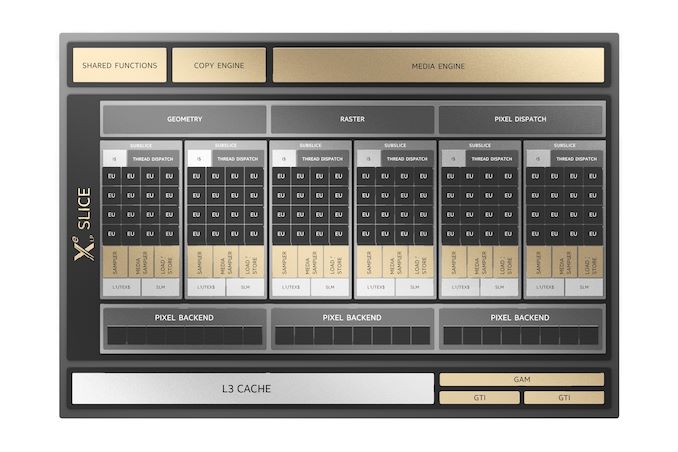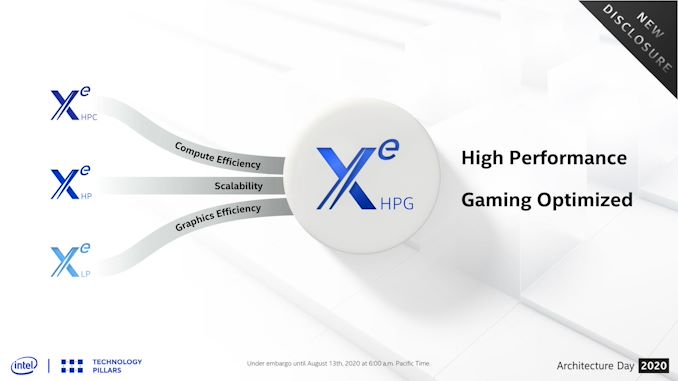Out of thin air and also he is cleverly using other rumours, so that the people believe he has exclusive sources. However not all is nonsense, for example I have to agree with his canceling Xe opinion, I don't think this is the case and the latest news from videocardz doesn't sound like Intel will cancel their discrete Xe graphics efforts.
News Intel GPUs - Intel launches A580
Page 27 - Seeking answers? Join the AnandTech community: where nearly half-a-million members share solutions and discuss the latest tech.
You are using an out of date browser. It may not display this or other websites correctly.
You should upgrade or use an alternative browser.
You should upgrade or use an alternative browser.
IntelUser2000
Elite Member
- Oct 14, 2003
- 8,686
- 3,785
- 136
Ponte Vecchio on 10nm? That would be a big step back. I wonder how they're going to hit their efficiency targets without 7nm.
Well it does say
Intel 10nm SF + External
I think the active interposer part will be on 14FFL(which is based on 10nm, just like 22FFL was based on 14nm), and the Rambocache will use 10nm SF.
- Nov 14, 2011
- 10,232
- 5,012
- 136
Lots of news yesterday- Xe-HPC, Xe-HPG, and Xe-LP all got updates:
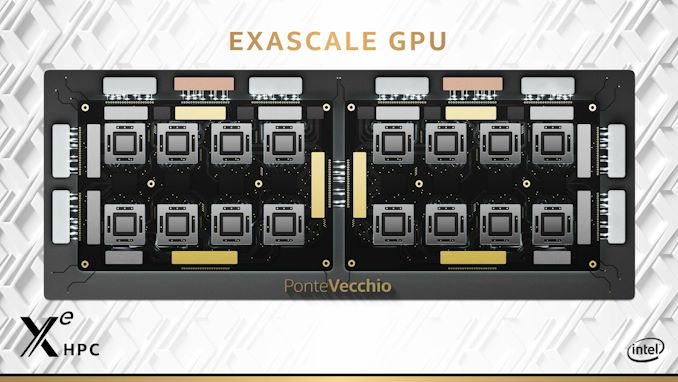
 www.anandtech.com
www.anandtech.com
Sadly not much detail on what Xe HPG actually looks like.

Intel Xe-HPC GPU Status Update: 4 Process Nodes Make 1 Accelerator
Sadly not much detail on what Xe HPG actually looks like.
Ok Intel confirmed they have a gamer GPU with Raytracing in the works, in 2021! DG2 wasn't expected before 2022 but seems like some "bad news" about Intels Xe/discrete graphics future were false. The Xe LP infos from yesterday look promising. It can scale up to 1.8 Ghz says Intel, so we should se DG1 running up to 1.7-1.8 Ghz. At 1.7 Ghz they can reach 2.6 Tflop FP32. This is more GTX 1050 Ti territory rather than 1050 non Ti.
On a further note, Intel rewrote their DX11 driver for Xe, it's build from scratch:
On a further note, Intel rewrote their DX11 driver for Xe, it's build from scratch:
- Nov 14, 2011
- 10,232
- 5,012
- 136
Ok Intel confirmed they have a gamer GPU with Raytracing in the works, in 2021! DG2 wasn't expected before 2022 but seems like some "bad news" about Intels Xe/discrete graphics future were false. The Xe LP infos from yesterday look promising. It can scale up to 1.8 Ghz says Intel, so we should se DG1 running up to 1.7-1.8 Ghz. At 1.7 Ghz they can reach 2.6 Tflop FP32. This is more GTX 1050 Ti territory rather than 1050 non Ti.
Wow, they can match the performance of a low end GPU from 4 years ago... so long as the drivers don't suck. That's not exactly a huge win.
IntelUser2000
Elite Member
- Oct 14, 2003
- 8,686
- 3,785
- 136
- Nov 14, 2011
- 10,232
- 5,012
- 136
Intel's Xe SG1 is DG1 but four of them in one device. Is it 4 chips in one package, or 4 packages? No one knows.
@NTMBK OTOH, Xe-HPG with 512EUs and 1.8GHz will be 14TFlops so it'll end up high mid-range at least, provided it arrives late-spring at the latest not Q4 next year.
Yeah, hopefully HPG will end up much more competitive! 2080ti level of TFLOPs is a good start. I just hope that they can actually utilise that compute power efficiently.
Wow, they can match the performance of a low end GPU from 4 years ago... so long as the drivers don't suck. That's not exactly a huge win.
1050 Ti is a midrange card using 75W of power. The lowend series is MX150-350, even the 1050 non Ti is faster than this.
I'm half in the camp that it's too early to write-off Intel's effort given it's a first gen product. On the other hand, they have a guy who's known for over promising and under delivering at the helm.
IntelUser2000
Elite Member
- Oct 14, 2003
- 8,686
- 3,785
- 136
I'm half in the camp that it's too early to write-off Intel's effort given it's a first gen product. On the other hand, they have a guy who's known for over promising and under delivering at the helm.
Fortunately he's not the sole guy influencing the whole thing. Gen 12/Xe has also been in the works far before Raja joined.
- Nov 14, 2011
- 10,232
- 5,012
- 136
Lots of tasty info in the HotChips talk!
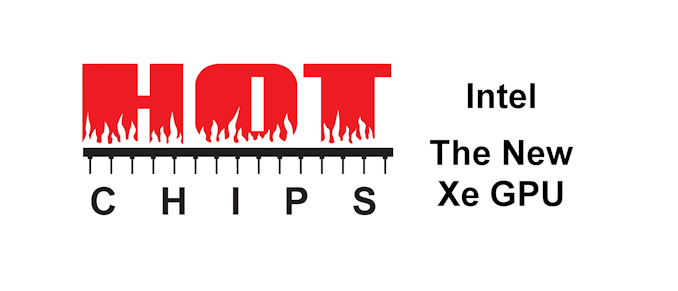
 www.anandtech.com
www.anandtech.com
Fixed function graphics hardware is optional based on segment. Explains why HPG and HP are separate- HP drops the raster graphics hardware.
Optional FP64 hardware, optional matrix unit.
Nice Tigerlake die shot:
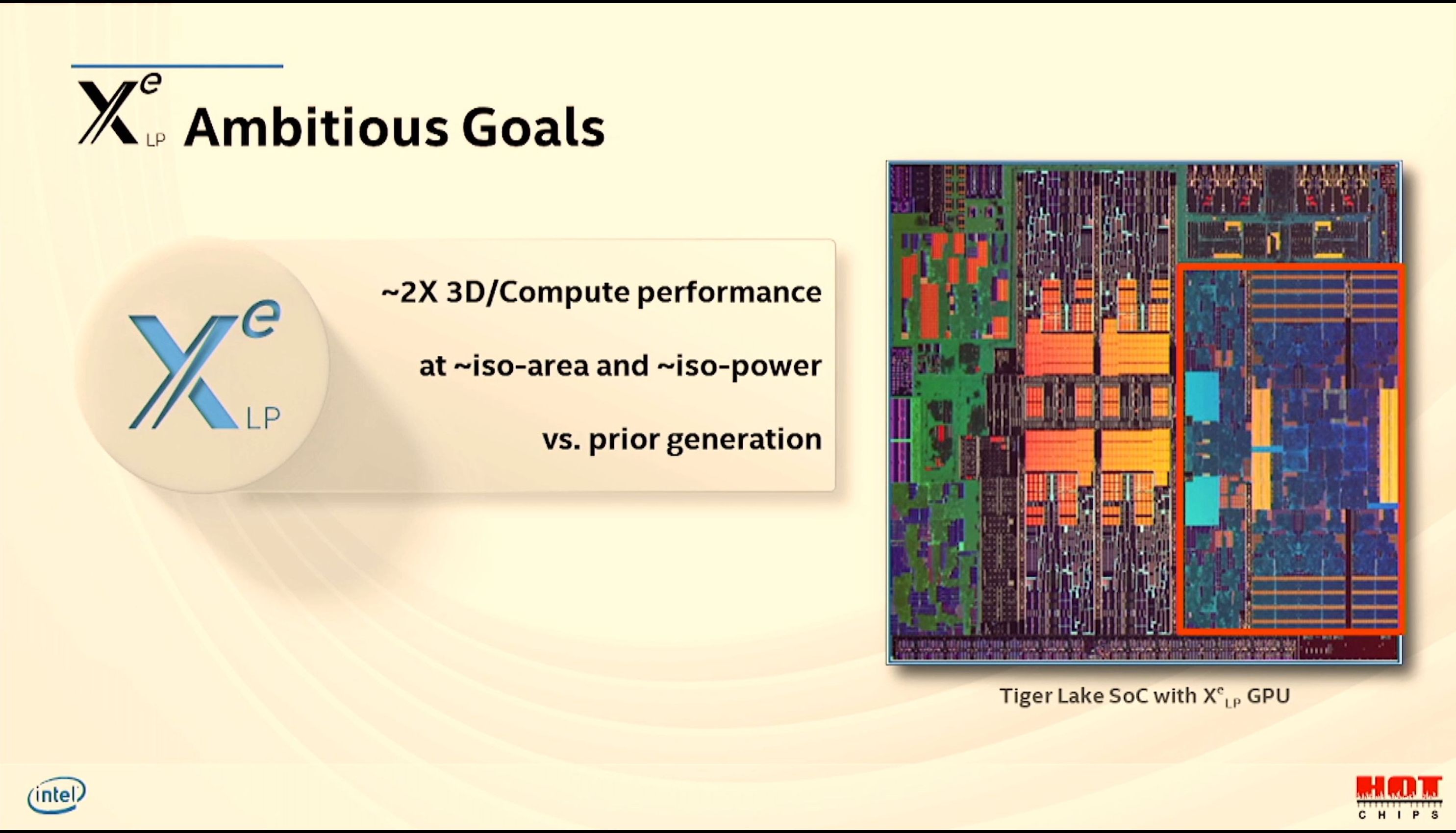

Hot Chips 2020 Live Blog: Intel's Xe GPU Architecture (5:30pm PT)
Fixed function graphics hardware is optional based on segment. Explains why HPG and HP are separate- HP drops the raster graphics hardware.
Optional FP64 hardware, optional matrix unit.
Nice Tigerlake die shot:

Q: Threads in an EU? A: Not changed much. 1 or 2, in TGL supports 7, little higher in the others
Gen12HP seems to get slightly more threads per EU, so the EUs are not exactly the same as in Gen12LP. Obviously Gen12HP is tweaked for higher performance.
Which has little bearing if any of the rumors about that individual are true. A lot of things existed before he joined somewhere, and he managed to mess things up almost ritually. The problem with people like him, including but not limited to the recently kicked out executive from Intel is they have massive egos and BDE to go with it, but don't use logic in their decisions and royally mess things up.Fortunately he's not the sole guy influencing the whole thing. Gen 12/Xe has also been in the works far before Raja joined.
IntelUser2000
Elite Member
- Oct 14, 2003
- 8,686
- 3,785
- 136
Which has little bearing if any of the rumors about that individual are true.
He was in ATI since 2001, and they had their ups and downs. It also means he had influence over AMD's graphics division ever since then too.
If you believe HardOCP's article from a while back, he didn't want to be at AMD and it said he even wanted to move to Intel!
When companies get bought, the cultures often clash and brings discontent among its employees because not everyone will agree to the decision. And then it'll end up being worse for both companies because neither have the will nor desire to cooperate and work.
And in those years prior to his move to Apple, how many excellent video cards did ATI have they lauded over NVidia? Here, I'll make it easier for you and give you a picture guide.He was in ATI since 2001, and they had their ups and downs. It also means he had influence over AMD's graphics division ever since then too.
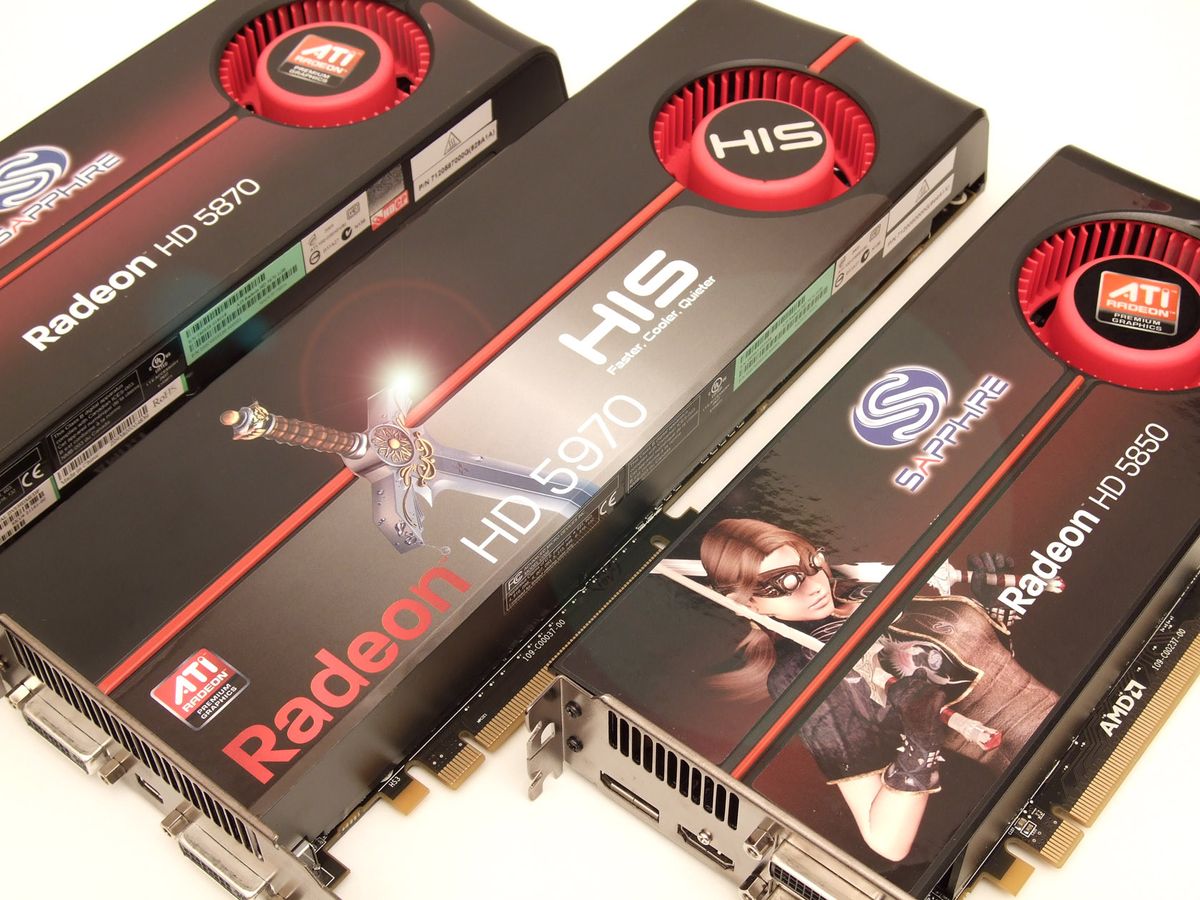
The 30 Year History of AMD Graphics, In Pictures
From the ATI Wonder in 1986 to the AMD Radeon RX in 2016, we take a look at the evolution of AMD graphics.
IntelUser2000
Elite Member
- Oct 14, 2003
- 8,686
- 3,785
- 136
And in those years prior to his move to Apple, how many excellent video cards did ATI have they lauded over NVidia? Here, I'll make it easier for you and give you a picture guide.
That I cannot say as its not my generation(or the generation I paid attention to).
So what's your verdict? They'll fail and the fault will mostly be due to Raja? So rest of the smart people there working on Xe(including more public figures such as Lisa Pearce and David Blythe) have zero effect?
You could be right, but you could also be wrong. I'm going to give him the benefit of the doubt(at least not blame current troubles entirely on him).
I wouldn't say fail or succeed. They'll float and progress until they find a breakthrough themselves. Intel's went down this road a few times. It may not be Raja, and it may be the next guy or woman who'll get Intel to seriously invest money into finding a breakthrough that does some radically cool stuff and edges out NVidia and AMD. Intel's first attempt is around a 1030 level almost to a 1050 but not quite. For a first attempt that isn't bad. I'll hold my opinions until their hardcore products come out. Don't get me wrong, I don't faith in dumb vloggers like a certain guy with a long neck who pulled some theories out of his ass. There is a definite market for RDNA2 and Xe on mobile where NVidia lacks. We're going to see some amazing stuff in the next decade and it's far too early to tell. I simply don't see Raja sitting at Intel for a long time. He's not a bad guy, don't get me wrong here.That I cannot say as its not my generation(or the generation I paid attention to).
So what's your verdict? They'll fail and the fault will mostly be due to Raja? So rest of the smart people there working on Xe(including more public figures such as Lisa Pearce and David Blythe) have zero effect?
You could be right, but you could also be wrong. I'm going to give him the benefit of the doubt(at least not blame current troubles entirely on him).
You forget that even the best hardware can struggle when fed crap. There's a lot of bad, inefficient game engines out there that truly suck.
IntelUser2000
Elite Member
- Oct 14, 2003
- 8,686
- 3,785
- 136
Intel's went down this road a few times. It may not be Raja, and it may be the next guy or woman who'll get Intel to seriously invest money into finding a breakthrough that does some radically cool stuff and edges out NVidia and AMD. Intel's first attempt is around a 1030 level almost to a 1050 but not quite.
There's too much of a trend to just give up when it doesn't work. Give it a chance and work on it for few generations. Not giving up right away will also retain customers better since their hardware won't be abandoned after a year.
If they release a 512EU version as Xe-HPG Spring-Summer they can aim it for solidly mid range, which is $400 nowadays.
That applies to employees as well. Intel fired Pat Gelsinger after the Larrabbee debacle when he could have got a pay cut or be assigned elsewhere. He would have been that engineer-CEO that people talk about. And he was actually great at it. No wonder he was the youngest CTO ever for the company.
Nowadays you might as well dangle a noose next to an employee as a reminder what will happen if a project fails. What about all the good they did prior to that failure?
As a sidenote I'm having this conversation with someone from the UK about this. He's a Mac guy and asked me about my thoughts on getting a new Mac Pro and I basically said if he's willing to write off the costs when Apple Silicon goes mainstream and Apple quickly dumps Mac Pros using Intel for their own hardware. Apple has said it'll be a slow smooth transition but it isn't unlike Apple to decide something else halfway down the road. So there will some software vendor support but for how long? I've got him into looking at the P620 for now but who knows. And if Apple's Apple Silicon doesn't make the cut in 4-5 years, for example, then what? Back to x86-64 we go?There's too much of a trend to just give up when it doesn't work. Give it a chance and work on it for few generations. Not giving up right away will also retain customers better since their hardware won't be abandoned after a year.
If they release a 512EU version as Xe-HPG Spring-Summer they can aim it for solidly mid range, which is $400 nowadays.
That applies to employees as well. Intel fired Pat Gelsinger after the Larrabbee debacle when he could have got a pay cut or be assigned elsewhere. He would have been that engineer-CEO that people talk about. And he was actually great at it. No wonder he was the youngest CTO ever for the company.
Nowadays you might as well dangle a noose next to an employee as a reminder what will happen if a project fails. What about all the good they did prior to that failure?
Yeah, it goes in line with other similar sayings. You can be a hero all your life, mess up badly once and it's all you'll be remembered by. He and VMWare have flourished since they mated. I just wish their support improved in that time too.
Apple's not switching Mac CPUs because of performance, or even cost, but primarily because of vertical integration. They're no longer slaves to the whims and failures of Intel, and they can build chips that fit the kind of Macs they want to offer exactly.And if Apple's Apple Silicon doesn't make the cut in 4-5 years, for example, then what? Back to x86-64 we go?
So they'd never switch back again, because then they wouldn't have the tight control anymore which they desired (and achieved in their iOS devices) in the first place. It wouldn't matter if one or more generation of chips deliver disappointing performance; Apple's Mac ecosystem is its own ecosystem and has never depended on cutting edge performance anyhow. It has always been user experience first, everything else second, third and so on.
So customers would continue to buy what Apple's offering them, just as they always have been. Not that there seems much risk of Apple screwing up right now, really. They've been owning the ARM SoC marketspace for years now in both in terms of absolute performance and power/performance ratio.
What's more interesting (although food for a different topic really) is how exactly they'll migrate their iMac Pro and Mac Pro product lines. Mac Pro tops out at 28 cores; such a chip requires the biggest R&D investment but also sells in the smallest numbers, making it difficult to earn back money spent on its development. Perhaps Apple will simply go back to multisocket chips like in the Mac Pro G5 and up until the Trashcan. So iMac gets the 12-core A14Y processor or whatever they'll call it; Mac Pro gets 2x 12-core processors. Something like that. *shrug*
You contradict yourself with your opener there. If their in house processors fail to show year over year improvement in future and other avenues are providing considerable performance increases, their users will drop them. We like to joke and say Apple fans are stuck to their machines, but their actual professional userbase will drop them and leave their fanatic low end, typical users to pick up the slack. I wouldn't put it past Apple to consolidate their stack in a few years and terminate low volume products.Apple's not switching Mac CPUs because of performance, or even cost, but primarily because of vertical integration. They're no longer slaves to the whims and failures of Intel, and they can build chips that fit the kind of Macs they want to offer exactly.
So they'd never switch back again, because then they wouldn't have the tight control anymore which they desired (and achieved in their iOS devices) in the first place. It wouldn't matter if one or more generation of chips deliver disappointing performance; Apple's Mac ecosystem is its own ecosystem and has never depended on cutting edge performance anyhow. It has always been user experience first, everything else second, third and so on.
So customers would continue to buy what Apple's offering them, just as they always have been. Not that there seems much risk of Apple screwing up right now, really. They've been owning the ARM SoC marketspace for years now in both in terms of absolute performance and power/performance ratio.
What's more interesting (although food for a different topic really) is how exactly they'll migrate their iMac Pro and Mac Pro product lines. Mac Pro tops out at 28 cores; such a chip requires the biggest R&D investment but also sells in the smallest numbers, making it difficult to earn back money spent on its development. Perhaps Apple will simply go back to multisocket chips like in the Mac Pro G5 and up until the Trashcan. So iMac gets the 12-core A14Y processor or whatever they'll call it; Mac Pro gets 2x 12-core processors. Something like that. *shrug*
I'm not contradicting myself. And users won't drop Apple; they're quite loyal and many will soldier on even with NO hardware upgrades at all, as they did when Mac Pro wasn't updated for (IIRC) 3 straight years before introduction of the Trashcan, and then was not updated for another 5 years or whatever it was before current Mac Pro came out on the market last year. Certain other Mac product lines have also gone multiple years without upgrades at times (Mac Mini and Air especially), and people still stuck with their Macs, and with Apple.You contradict yourself with your opener there. If their in house processors fail to show year over year improvement in future and other avenues are providing considerable performance increases, their users will drop them.
With iOS and Mac hardware sharing the same basic hardware architecture, the risk of no upgrades at all for any major length of time is basically going to be zero. I'd say two years at most between major SoC overhauls; second-year upgrade may be a reheated first-year SoC, like current iPad Pro's A12Z.
And you're loco if you think any substantial amount of people upgrade their machines on a yearly cycle, pro users or no. That's not happening, because it's not even remotely cost efficient. And like I said, essentially no users buy Macs for the hardware performance. There's faster options out there for pretty much everything you can imagine. And this certainly includes the Mac Pro, whose best graphics option is a several-years-old GPU which was ho hum from day friggin' one!
Technically, the entire Mac line is low volume, yet Apple still persists with it, and arguably spends more resources on it now than ever. So I wouldn't think that's any sort of issue going forwards.I wouldn't put it past Apple to consolidate their stack in a few years and terminate low volume products.
Apple's not switching Mac CPUs because of performance, or even cost, but primarily because of vertical integration. They're no longer slaves to the whims and failures of Intel, and they can build chips that fit the kind of Macs they want to offer exactly.
Second line contradicts the first. Vertical integration is only about bringing multiple stages of a device pipeline under your own control. It doesn't refer to performance or value. And in any case, Apple is still under the whims of its third party foundries because Apple is a fabless company. Their design is in house, but the productions of their processors are third party. The other components come from as much as 20 other companies. Production of the phone and iPad chassis are third party. Corning is third party. Apple are still "slaves" to the whims of third party vendors who produce software for macOS and Windows right now.
Apple sells a third of what HP, the leading Windows and Linux vendor sells. That's computers, not including iPads. The Mac Pro is an ultra low volume seller, and it may be one of the first cuts for Apple. I know a few people who just bailed on ordering a 14-30K GBP systems because of Apple's plans and just how they may be treated by software they rely on to pay their bills. I've got most of them looking into the Lenovo P620 with the the fancy warranty for onsite repairs in a 6 hour window. They were blown away by the performance of the 3995WX TR Pro. They'd heard and seen benches of the 3990X but didn't feel comfortable using a small SI or building it on their own. MacBook Airs, MacBooks and MBPs are volume sellers. Not users about the iMac or the iMac Pro.Technically, the entire Mac line is low volume, yet Apple still persists with it, and arguably spends more resources on it now than ever. So I wouldn't think that's any sort of issue going forwards.
Mac Pros get purchased in large numbers by studios and editing houses. However, given the latent performance by Intel in the face of a "new" AMD and with how Apple are moving things along to their own processors, it's the inverse of the PowerPC to x86 switch and it leaves room for a lot of questions. I suspect that once other SI and major OEMs like HP or Dell get the picture that Intel is going nowhere, we'll see Threadripper Pro machines being more common. It's unprecedented performance, and I wouldn't be surprised if these major OEMs invest in AMD because it'll help their bottom dollar to move more machines with bigger margins for them.
Last edited:
The add-in accelerator card is great for FCPX. Adobe only just beta'd the function back in May for macOS in their product, with the rest to follow. Afterburner is great if you only use Apple software or software that has full, stable support. I'm not loco. I'm old enough to remember when there was a much faster, higher performing processor nearly every 7-9 months on the dot. I don't want to sound ageist and assume you're young, but things were a lot different before Intel steamrolled AMD for a decade. If new AMD keeps providing incredible gains in performance YoY, there's absolutely no reason to sit on the same hardware for years at a time unless you can't afford it. Though, anyone who uses their work for professional reasons and can write off their spending, it's a no brainer for them to get something new almost yearly... if the stars align.With iOS and Mac hardware sharing the same basic hardware architecture, the risk of no upgrades at all for any major length of time is basically going to be zero. I'd say two years at most between major SoC overhauls; second-year upgrade may be a reheated first-year SoC, like current iPad Pro's A12Z.
And you're loco if you think any substantial amount of people upgrade their machines on a yearly cycle, pro users or no. That's not happening, because it's not even remotely cost efficient. And like I said, essentially no users buy Macs for the hardware performance. There's faster options out there for pretty much everything you can imagine. And this certainly includes the Mac Pro, whose best graphics option is a several-years-old GPU which was ho hum from day friggin' one!Unless of course you're doing digital video editing, in which case Apple's add-in accelerator board may be your best option on the market right now, who knows.
If you're a professional editor or studio, you offload render work. You also work off of another source. I'd provide an example of what we employ at work but it would give away who I work for. There's only two companies in the world that manifest that kind of in-house power.
Last edited:
TRENDING THREADS
-
Discussion Intel current and future Lakes & Rapids thread
- Started by TheF34RChannel
- Replies: 23K
-
Discussion Zen 5 Speculation (EPYC Turin and Strix Point/Granite Ridge - Ryzen 9000)
- Started by DisEnchantment
- Replies: 9K
-
-
Discussion Intel Meteor, Arrow, Lunar & Panther Lakes Discussion Threads
- Started by Tigerick
- Replies: 7K
-

AnandTech is part of Future plc, an international media group and leading digital publisher. Visit our corporate site.
© Future Publishing Limited Quay House, The Ambury, Bath BA1 1UA. All rights reserved. England and Wales company registration number 2008885.


